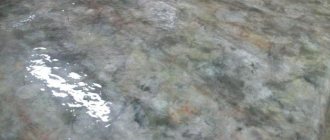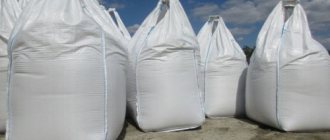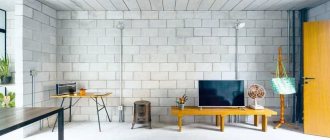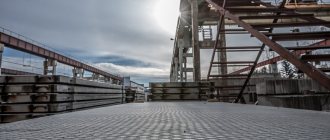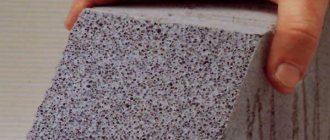Do-it-yourself fiberglass concrete
Traditional concrete and its varieties have long been firmly established in the life of modern people. Its strength, durability, and relative environmental friendliness are beyond doubt. But building materials are constantly being improved, their performance qualities are improving, their areas of application are expanding, and new manufacturing technologies are being developed.
Such an innovative building material today is called glass fiber reinforced concrete, from which many different products are made. Balustrades for stairs and steps made of glass fiber reinforced concrete, railings for balconies and loggias, as well as decorative elements. This is not the entire list of products made from glass fiber reinforced concrete. What is this material, what are the features and advantages of its use, and is it possible to prepare glass fiber reinforced concrete at home?
Ease
Hinged facade panels made of SFRC are lighter and more convenient to install, as they are devoid of reinforcement
This is especially important at high altitudes. Increased plasticity indicators allow them to be made in large format - up to 10 m2 in area or even more, with a thickness of 15-30 mm
The panels are mounted on the subsystem using embedded parts.
It is quite natural that one of the largest integrated residential development projects implemented by the KROST concern - the Nevsky residential complex - could not do without the introduction of SFB. In this project, the material has a special role: to create an image that would combine the spirit of industrial buildings, reminiscent of the past of this site, and a new “classic” in the form of an order.
"Nevsky" is being built on the territory of a former machine-building plant - the old factory buildings reconstructed into the "Nevsky Prichal" trade and office gallery are reminiscent of this. They retain metal load-bearing trusses. This industrial spirit is also reflected in the dark, “aged” clinker brick chosen for the cladding of residential buildings. We are talking about buildings 3 and 4, located closer than others to the main pedestrian and vehicular flow along Admiral Makarov Street, and the six-story part with offices attached to them, acting as a kind of screen. On the other hand, the image formed by the name “Nevsky” itself refers to the St. Petersburg classics and is embodied in an abundance of order details, the best solution for which was fiberglass concrete.
Glass fiber reinforced concrete for facade
SFB frame decors are recognizable in the modern city primarily due to their precise, graceful geometry, light or bright shades, or surprisingly clear finishing patterns. It is also possible to paint SFRC and produce a solid with pigment added during mixing. Unpainted SFRC looks natural in clean grays and whites - an effective contrast to the brick and stone fragments.
For cottages and private houses, SFB easily recreates classical architecture. But for modern industrial styles and techno facades, SFRC products are no less relevant, because any molding is possible - corner and curved panels, thin shells of fantasy shapes, complex shells, facade decor of futurism and science fiction.
Glass fiber reinforced concrete decor
Not only the plastic, but also the artistic capabilities of SFB are amazing. Plastic is the result of volumetric thin reinforcement without any frame. The solution to the shape of the product can be absolutely non-trivial, and in addition, the choice of surface texture and the widest range of colors. SFRC imitations of stone, wood, cast iron are realistic and aesthetic.
SFRC products can have a fine finish, while the design of the panels takes into account installation on a supporting frame frame. The decor for ancient architecture, made of SFRC, is unusually realistic, but this is only one of the areas of facade decoration. For private houses, they use elements of window and door frames, products for creating porticoes, thin screen solar panels, roofing and gutters elements.
For roofing coverings, SFRC has many advantages and at the same time perfectly imitates tiles and slate, but without their disadvantages of fragility and heavy weight. On pitched roofs, SFRC slate is indistinguishable from “natural” slate, but is attached without preliminary drilling, since the strength of SFRC allows fastening with slate nails, and splitting during installation is impossible.
For landscaping private areas, SFB is unique; it allows you to arrange durable and picturesque small forms, fountains and ponds, benches and fences, gazebos in any style and in a very complex configuration. Making glass fiber concrete yourself is difficult, but possible. One of the nuances of kneading that requires skill is mixing the solutions “in one direction” so that the glass fiber is distributed evenly. For spraying it is possible to use pneumatic guns, for mixing - a regular concrete mixer. When making home decorations with your own hands, special molds are used that have a glass bottom to produce polished tiles, and for textured tiles, rather expensive silicone molds are needed. Cutting microfiber is simple and can be easily done with special scissors, but protection from the finest flying microfiber is a very serious matter: a respirator, goggles and gloves, and all personal protective equipment are required.
Mixtures with fine fiber harden quickly, so they are prepared in small quantities.
Installation of glass fiber reinforced concrete
Thin panels are mounted on a subsystem made of a metal profile (galvanized or stainless steel). The weight of SFRC products is small, which not only simplifies delivery and installation, but also saves frame material. SFB is resistant to the negative environment - heat and humidity changes, water, and even chemical reagents, and is also absolutely non-flammable and very durable. The service life of SFRC cladding is no less, if not longer, than the period of operation of the load-bearing base of the structure.
Monolithic house construction requires a special approach to protecting the end sections of floors - cold bridges and areas difficult for architectural finishing. SFRC panels solve the problem of facade aesthetics to the fullest extent, and also do not load load-bearing structures. The weight of SFRC cladding is small, the thickness is only 15 mm, and installation is quite simple. In addition, there is a wide range of decorative possibilities - imitating brick and stone, choosing the colors and texture of the facings of the ends of the monolithic floor. The panels are fastened to monolithic concrete using metal anchors, and the joints are sealed.
What is glass fiber reinforced concrete
A new type of concrete is glass fiber reinforced concrete, a composite material based on traditional concrete. The main distinguishing component of glass fiber reinforced concrete is glass fiber. Glass threads introduced into the concrete solution make this building material light and reliable. Thanks to its unique properties, it enjoys a fairly high reputation among builders.
Like any concrete, the new composite consists of a binder, aggregate, water and, in some cases, special additives. One of two types of cement is used as a binder in the production of glass fiber reinforced concrete: Portland cement M-500 or alumina cement. Fill the solution with fine quartz sand and glass fiber.
One of the most important conditions for preparing a high-quality solution is a competent approach to choosing a binder. The fact is that Portland cement contains calcium hydroxide, which in contact with water has a destructive effect on glass fiber.
Aluminous cement, which intensively crystallizes and quickly hardens, interacts well with the glass thread and enhances its reinforcing properties. But the use of alumina significantly increases the cost of glass fiber reinforced concrete production. In addition, alumina solutions require absolute precision in the manufacturing process; the slightest deviation from the recommendations leads to a loss of basic qualities, in particular, to a decrease in the strength of glass concrete.
So what is the solution? In the selection of glass threads that are resistant to alkalis. These include monofilaments (roving or roving) of zirconosilicate, calcium-sodium silicate, aluminoborosilicate and quartz silicate threads. The proportion of glass fibers in the solution should not be less than 3-5% of the total mass.
Advantages and disadvantages of glass fiber reinforced concrete
Ordinary concrete is traditionally reinforced with steel reinforcement; it is strong, but not plastic and very heavy. Glass fiber reinforced composite concrete has many advantages over it:
- Glass threads, as reinforcement elements, are not afraid of corrosion;
- Like steel reinforcement, glass threads perfectly withstand compressive loads, but in addition, they can withstand significant loads in both bending and tension;
- The low weight of the structures ensures less load on the foundation and easier transportation of finished products;
- The material is plastic, it is used for the manufacture of products with complex configurations;
- The total density of glass fiber in the composite mass is significantly higher than the density of steel reinforcement;
- Rapid hardening of the solution ensures high density;
- The possibility of introducing color pigments into the mass of the composite makes it possible to obtain colored products for decorating facades.
Glass fiber reinforced concrete also has disadvantages:
- Some types of glass fiber cannot be used in Portland cement mortar;
- Fast hardening compared to conventional concrete. Fast installation required.
These shortcomings are easily compensated for by purchasing fiberglass, alkali-resistant material and producing glass fiber reinforced concrete in small portions.
Fiberglass concrete, made on the basis of traditional concrete mortar, has some common properties with it: it does not burn, does not rot, and is not afraid of frost and moisture.
Glass fiber reinforced concrete products: how and where to use glass fiber reinforced concrete?
The solution is sprayed onto the surface of the mold using a pneumatic gun. The mixture, prepared in a concrete mixer or by hand, is poured into pre-prepared molds. Before using the mold, it must be lubricated with any mineral oil.
To produce slabs with different surface textures, various shapes are used:
- coated inside with polyethylene for smooth;
- with glass bottom for polished;
- silicone molds for textured surfaces.
What can you make from homemade composite concrete?
High-quality performance properties allow the use of glass fiber reinforced concrete in the manufacture of:
- Thin curtain panels for cladding a ventilated façade;
- Elements of facade decor;
- High-strength fencing for balconies and loggias;
- Roofing elements;
- Panels for formwork;
- Designs for landscape decoration;
- Stair elements.
The ability to select glass fiber for the manufacture of products with different chemical compositions and strengths makes this composite material universal. Products made from it can be used in sewerage systems, waterproofing, and pipelines.
Use in Russia
For detailed information about the company’s creativity and projects, visit the website https://www.antika-plus.ru.
The solution for each specific case can be made through the following options:
- single-layer panels with stiffeners;
- permanent formwork with filling.
The structural flexibility of glass fiber reinforced concrete provides an opportunity to escape the monotony of painted steel structures, plastics, massiveness and limited forms of concrete.
Can also be used to make large diameter pipes. It is reinforced with both chopped fiber and alkali-resistant fiberglass meshes.
Save time
SFRC allows you to maintain a high construction speed. Buildings 3 and 4 of the Nevsky residential complex were built in record time: construction began just a year and a half ago, facade, finishing and landscaping work was carried out simultaneously, and on the eve of 2022 the buildings received permission to be put into operation. At the same time, the volume of fiber-reinforced concrete elements made and installed on the facades amounts to more than 4,000 square meters. The significant production and warehouse areas of the factory, where it is possible to simultaneously work with large volumes of products, the technology for manufacturing elements, and quick and convenient installation also played a role here.
***
The main stages of creating a fiber-reinforced concrete product are a chain of five operations: first there is a sketch, then a drawing, on the basis of which the model makers and sculptors of the factory make the model. The next step is the production of a mold created according to this model. Then comes the stage of pneumatic spraying of the concrete itself with the addition of chopped fiberglass. And finally, “aging” of finished products, during which they reach their design strength. Installation on facades is carried out using embedded parts or through fastening, and since the products are hollow and thin-walled, this is not difficult to do.
Fiber-reinforced concrete decor covers the facades of 28 and 25-story buildings almost entirely. In the lower part there are reliefs depicting sea animals - fish, turtles, skates, as well as textured inserts, columns, loose pediments, and rods. Sketches for them were developed by the leading architect of A-Project.K, Alexander Dmitriev. In the upper zone, the facades are divided by ornamented half-columns and niche inserts, in which spectacular night lighting is mounted.
Both residential buildings are united by a stylobate: underground there is a two-level parking and technical rooms, on top there is a raised, landscaped courtyard, accessible by a wide staircase. And here again SFRC comes in handy: railings, balustrade bases, ebbs and other elements are made of it, looking impressive against the background of dark red clinker.
SFRC is also used in yard landscaping for the manufacture of small architectural forms, for example, chess tables and benches, retaining walls of front gardens, flowerpots and other elements. Surfaces are protected from weathering by a hydrophobic composition. Cracking and color loss are prevented through the use of high quality components and strict adherence to production technology. In the center of the courtyard stands an entire fiber-reinforced concrete pavilion - an analogue of the Ice Cave in Zaryadye Park - with the function of a gazebo. It was created right on site, using 3D modeling and scanning, as well as spraying fiber-reinforced concrete onto a pre-prepared spatial frame.
Currently, construction of two more buildings of Nevsky is underway. SFRC is again used here: Tuscan columns are now being installed from it on building 5, acting as frames for panoramic glazing of the facades. The dimensions of the elements are more than 6 meters.
Next to Nevsky, KROST built its own technology park, in which the concern’s office is located. Here, SFRC is used in interiors, in the form of 3D relief panels with a unique honeycomb pattern. These elements decorate the spacious atrium spaces created for educational courses, lectures and other public events. The maximum size of panels exceeds 7 meters. Due to the improved composition of the material, the surfaces of the products are of high quality and do not require finishing.
The concern's experiments with new material did not go unnoticed on the market: today, Fibrol factory products are used in the cladding of metro stations, as openwork facade screens for residential complexes and administrative buildings, and in urban improvement projects, which have been repeatedly awarded the most prestigious awards.
Manufacturing technology
Now let's talk directly about the production of fiber-reinforced concrete. Let's start with a brief overview of the applicable equipment.
Equipment variability
Since there are several technologies, the variability of equipment may be different. Let's take a closer look.
If the premix pneumatic spray method is used, then the equipment for the production of fiber-reinforced concrete will need the following:
- The mixer is designed for high-quality mixing;
- An air gun is needed to spray the premix;
- Pumping station equipped with a peristaltic pump.
The technology for producing glass fiber reinforced concrete using the pneumatic spray method requires the following set of machines:
For a high level of automation, additional equipment for fiber-reinforced concrete may be required. For example, it is worth purchasing a compressor that can ensure the operation of technological equipment. Spring rollers are necessary to compact the mixture.
Fiberglass concrete production also requires the presence of molds for creating certain products. The flexible form is made of polyurethane, and the hard form is made of chipboard or plastic.
Equipment for glass fiber reinforced concrete: choosing material for making molds:
These forms are distinguished by their durability. With their help, you can make a product even with a negative edge.
- Peculiarities
- Advantages of the material
- Disadvantages of reinforced composite
- Scope of use
- Material composition
- Manufacturing technology
- Results
The material is dense, fast-hardening and mechanically strong even in a relatively small layer
Let's consider the features, characteristics, scope of use and manufacturing technology of concrete reinforced with fiberglass reinforcement.
What is glass fiber reinforced concrete
To increase the strength characteristics of concrete, it is reinforced, after which reinforced concrete is obtained, which was described earlier. However, the use of metal binders seriously adds weight to concrete structures. In addition, the disadvantage is the possible corrosion of the reinforcing elements over time.
Glass fiber reinforced concrete is completely free from all of the above disadvantages. For its production, glass fiber is used as filler and binding elements. As a result, not only the strength characteristics of concrete increase, but also its other indicators, such as frost resistance, impact resistance, etc., improve.
Anyone familiar with the production of ordinary concrete knows that inert materials - gravel, sand and crushed stone - act as fillers for it. As a result, the strength and various other indicators of concrete structures, such as compression or tension, are not at the highest level.
It is a completely different matter when fiberglass is used as a filler for concrete. The long fibers randomly located in it make it possible to increase tens of times the tensile strength and compression properties of the material, resulting in a completely new building material, the name of which is glass fiber reinforced concrete.
Composition and characteristics of glass fiber reinforced concrete
The main materials for the production of glass fiber reinforced concrete are: alkali-resistant glass fiber and Portland cement of grades no lower than 500 or 700, as well as quartz sand. To improve the molding, aesthetic and technological characteristics of glass fiber reinforced concrete, various types of additives can also be added during its production.
Well, it goes without saying that to give the concrete mass the desired consistency, either water or liquid glass is used.
The difference between ordinary concrete and glass fiber reinforced concrete is significant. If we highlight the main advantages of glass fiber reinforced concrete, they are primarily as follows:
- In lightness - glass fiber reinforced concrete is much lighter than ordinary concrete, but no less durable;
- In higher strength indicators - both bending and compression-tension;
- A significant difference between concrete and glass fiber reinforced concrete is also observed in tensile strength, which is five times higher for glass fiber concrete;
- The same applies to the higher impact strength compared to conventional concrete (145 times more);
- Improved characteristics in terms of frost resistance (up to 300 cycles).
As you can see, glass fiber reinforced concrete is a unique building material of its kind, which is much better in its characteristics than conventional concrete, the main filler of which is crushed stone.
Prices
The cost of glass fiber reinforced concrete in Moscow is determined by several factors. First of all, the price of raw materials and the complexity of production technology are taken into account. To produce 1 m² of panel, the following components are used:
- Fiberglass (produced in Japan and costs $6-7 per kg. To create 1 m² of surface 20 mm thick you need 3 kg of raw materials, i.e. the cost will be $15-18.
- Cement - $7-8.
- Quartz sand - $3-4.
The total cost of the material will be $25-30.
Purpose and scope of application
The use of fiber-reinforced concrete in construction work can achieve a number of positive effects, including:
- reduction of the total weight of the structure;
- preventing the formation and spread of cracks on the wall surface;
- increasing the strength of the wall;
- thinning wall structures;
- application of new and more advanced construction technologies;
- obtaining the appearance inherent in wood and stone finishing, but with more optimal performance properties and a simpler installation process;
- finishing of facades with curved geometry;
- reconstruction and restoration of old buildings, the lightness of building materials is especially relevant in this matter;
- elimination of uneven areas of the facade;
- obtaining a durable and smooth surface for further decorative finishing work.
Using fiber-reinforced concrete, objects with various features are finished, namely:
- cladding of apartment and private houses and cottages;
- design of shopping centers, hotels, sports complexes, airports, supermarkets, government and public facilities;
- finishing of ventilated facades;
- interior decoration;
- cladding of balconies.
Fillers for obtaining various properties by the material
Fiberglass , basalt and steel fibers are used to increase strength and load-bearing capacity, however, due to the high thermal conductivity of these materials, walls made from them are cold. This type of concrete is called architectural or facade concrete and is used to create various decorative elements.
Plastic and polyethylene fiber are used to produce concrete with balanced characteristics - such a material has average strength and thermal conductivity.
Wood wool is used to impart high heat and sound insulating properties to concrete, but the load-bearing capacity drops sharply.
In addition, the high water absorption of wood leads to a reduction in the service life of concrete.
Indeed, during frosts, the water contained inside the wood turns into ice and destroys nearby areas of cement stone.
Even adding sand to concrete does not allow achieving the same strength and load-bearing capacity that is inherent in fiber-reinforced concrete with other fillers.
How to make glass fiber concrete with your own hands
Do-it-yourself glass fiber reinforced concrete is prepared using several technologies, which are directly dependent on its application:
- pneumatic spraying into molds for products;
- preliminary mixing of all components in a concrete mixer;
- manual mixing (for small volumes of mixture).
The advantages of pneumatic spray include separate preparation of the mixture, precise dosage, speed of application and quality (uniformity) of the solution. The main advantage of this method is the automatic grinding of glass fiber at the outlet of the pneumatic gun nozzle.
In turn, it is the special gun and its high cost that make pneumatic spraying not the most convenient method in private construction. However, if it is possible to rent equipment at an affordable price, there is no point in abandoning this method.
The production of glass fiber reinforced concrete in a concrete mixer is practically no different from the technology for preparing conventional concrete mortar. All components except fiber are placed in the concrete mixer and the solution is mixed. Then add cut glass thread to the concrete mixture and mix again for five minutes.
The fiberglass concrete is ready. The main task: the mixture must be processed as soon as possible, otherwise it will harden. To prevent this from happening, it is recommended to prepare the solution in small portions. The preparation of glass concrete by manual mixing has only one feature: to evenly distribute the fiber fiber throughout the mass of the solution, it is stirred in one direction.
Technology for manufacturing glass fiber reinforced concrete using vibration molding
There is another technology for the production of glass fiber reinforced concrete, which experts call a method for the production of small-sized products - vibroforming. Forms with ordinary concrete mortar are placed on a horizontal surface with a vibrating mechanism and chopped fiber is added during the process. This method not only promotes uniform distribution of glass reinforcement throughout the entire volume of the solution, but also makes it more dense.
To make colored products from glass fiber reinforced concrete, concrete coloring pigments are added to the solution. Considering that the glass threads remain white, you can get a beautiful textured pattern. For single-color products, special colored fiber is purchased.
Before use, the monofilament is cut with special scissors into pieces of the required size.
At the same time, do not forget to take precautions - use glasses, a respirator, and special gloves. Do not forget that the maximum length of fiber fibers for glass concrete should not exceed 7.5 cm
In conclusion, we can once again note the need to prepare the mixture exactly according to the instructions and then everything will work out!
Equipment for the production of
Mortar pumping stations
They are responsible for dosing and supplying sand-cement mortar to spray guns. These stations are distinguished by maneuverability and ease of use. They contain:
Pneumatic spray gun (concentric and for applying a topcoat)
Electric mixer AST
These are the first and still popular mixers on the domestic market, which are several times more efficient than both manual mixing and conventional electric mortar mixers. The design includes:
All important elements of the system are protected from the ingress of water, cement and sand.
No less important elements in the production of glass fiber reinforced concrete are: a compressor, molds for products, spring rollers for compacting the mixture.
Advantages and disadvantages
Modern equipment and new production technologies using high pressure and steam processing make it possible to produce material with excellent performance and aesthetic qualities. Consumers choose fiber-reinforced concrete panels due to their positive qualities.
- Long service life. The duration of use of the panels varies in the range of 25-50 years.
- Light weight of products. Slabs and siding panels are relatively easy to lift, install, transport and store. And the load on the wall is also reduced, and less powerful means are needed for fastening.
- Simple and convenient installation. The technology for installing slabs is much simpler and less expensive than that of plaster. The large size of the panels reduces the amount of work and installation tools required for fastening. In addition, it is easier to detect and correct unevenness when installing panels. Installation work can be carried out with a minimum set of tools and a small amount of knowledge about installation techniques. Moreover, work can be carried out in subzero temperatures.
- Versatility. The panels are presented in various format and size options, which allows you to select products for finishing surfaces with various features.
- High strength. Fiber cement panels withstand shock loads, vibration, friction, and bending pressure well.
- Good thermal insulation properties. Ensured by the use of cellulose filler, they reduce the power of the necessary heat-insulating materials in the finishing, for example, the thickness of the mineral wool layer.
- Frost resistance. The products retain their structural integrity and appearance throughout many freezing/thawing cycles. This fact makes them an excellent facing material for regions with a harsh and continental climate, in which hot summers give way to cold winters, which corresponds to almost the entire territory of the Russian Federation.
- High waterproofing properties. Thanks to special additives, the panels are not afraid of moisture and can be washed using water on both the front and back sides.
- Resistant to temperature changes.
- Do not corrode, do not rot, do not dry out.
- Completely environmentally friendly composition. Natural raw materials and non-toxic additives are used in production; microparticles of the material do not provoke allergic reactions and do not contribute to negative processes in the body. No asbestos or harmful resins.
- Resistant to sunlight. The color of fiber-reinforced concrete does not deteriorate under the influence of infrared radiation throughout its entire service life. Ultraviolet radiation does not destroy the structure of the coating - it does not lead to cracking, like some finishing materials.
- Good sound insulation. Reduces the level of incoming and outgoing sound.
- Wide choose. The ability to choose extends not only to color and its shades, but also to the shape and texture of the panel coating.
- Easy cleaning. The material cleans itself in the pouring rain; in addition, you can wash the surface with a garden hose.
- Absolute fire safety. The material is 100% non-flammable and non-smoldering, and also does not melt when exposed to direct fire.
In addition to positive qualities, fiber-reinforced concrete panels have several disadvantages.
- Vulnerable to prolonged exposure to moisture. Despite the high waterproofing qualities, with prolonged exposure to water, the cement in the composition of the products still begins to absorb water. Saturation can increase up to 10-20% and lead to slight deformation of the panels - up to 2%, which does not in any way affect the appearance or structural integrity; the flexibility of the panels completely compensates for this phenomenon.
- Specifics of installation work. Despite all the positive aspects in this matter, there is one caveat - large panels require installation by at least two people, which can cause some difficulties.
To learn about what fiber-reinforced concrete is, see the following video.

